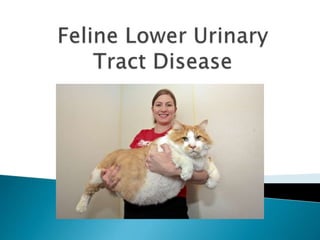Feline Lower Urinary Tract Disease
- 2. ÔÅΩ 5 kg, 8 year old, mc DSH ÔÅΩ Recently rehomed ÔÅΩ Previous history of Urinary Tract Disease ÔÅΩ Free fed veterinary therapeutic food to manage struvite urolithiasis ÔÅΩ Indoor/Outdoor ÔÅΩ Recently urinated blood
- 3. ÔÅΩ WNL ÔÅΩ BCS 4/5 ÔÅΩ Bladder not palpable ÔÅΩ U/A- blood 3+, protein 2+, pH 7.0
- 4. ÔÅΩ Urolithiasis ÔÅΩ Urinary Tract infection ÔÅΩ Idiopathic ÔÅΩ Atypical UTI ÔÅΩ Trauma to bladder or urethra ÔÅΩ Urethral Stricture ÔÅΩ Inflammation ÔÅΩ Neoplasia ÔÅΩ Iatrogenic ÔÅΩ Neurogenic
- 5. ÔÅΩ Type of Crystals ‚ó¶ Struvite - Magnesium Ammonium Phosphate ÔÇñ Forms in Alkaline Urine ‚ó¶ Calcium Oxalate ÔÇñ Forms in Acidic to neutral urine, dependent on the presence of Oxalate ÔÅΩ Others ‚ó¶ Amonium Urate, Calcium Phosphate, Uric Acid, Cystine, Xanthine and Matrix
- 6.  More common in Geriatric cats (12 yr +)  Causes ◦ Bacterial  E.coli, Staph/Strep, Proteus/Klebsiella, etc… ◦ Viral  Can predisposes animals to crystal formation ◦ Not common in cats (70% sterile)
- 7. ÔÅΩ Most common in neutered, sedentary, overweight, castrated male cats ÔÅΩ Consuming dry foods ÔÅΩ Young adult (1-10 years) ÔÅΩ Likely stress related ÔÅΩ Frequency of feeding???
- 8. ÔÅΩ Urinalysis ÔÅΩ Urine culture and sensitivity ÔÅΩ Biochem ‚ó¶ Increased Ca2+, Renal Values (Urea, Creatinine, K) ÔÅΩ CBC ‚ó¶ Inflammatory leukogram ÔÅΩ Radiographs, Ultrasound
- 9.  Depending on the findings, urinary tract disorders can be treated by: ◦ Nutritional ◦ Medication  Anti-inflammatory  Antibiotics – Useful in UTIs only!!! ◦ Decrease Stress ◦ Surgery ◦ Benign Neglect – Useful in idiopathic only!!!!
- 10.  The most important therapeutic is Antibiotics.  Anti-inflammatories are also helpful. Idiopathic Cystitis Treatment • The best treatment is to prevent it – concentrate on decreasing stress – increase their water consumption.
- 11. ÔÅΩ Urinalysis showed struvite crystals, ph>6.5: ‚ó¶ Infection present? ÔÇñ Treat with antibiotics ‚ó¶ Do radiographs to look for uroliths, ÔÇñ if present begin calculolytic diet (ex: s/d). ‚ó¶ Recheck at 2 weeks ‚ó¶ Recheck rads to evaluate for resolution of uroliths ÔÇñ If present, continue feeding food for 1-2 month
- 12. ‚ó¶ If resolution is obtained ÔÇñ continue dissolution for 2-3 months with monthly monitoring ÔÇñ Then, switch to a preventative diet because the calculolytic diet has too much NaCl and too acidifying for long term use ‚ó¶ if there is no change in size after 2 months. ÔÇñ Surgery should be considered ÔÇñ Switch to preventative diet (ex: c/d) ‚ó¶ Monitor every 6 months with a U/A.
- 13. ÔÅΩ Urinalysis revealed calcium oxalate crystals, acidic pH ‚ó¶ Culture urine and treat infection if needed. ‚ó¶ Radiograph to look for uroliths, ÔÇñ Make sure to check kidneys and bladder ‚ó¶ If present, the only option is surgical removal. ÔÇñ Do post-op radiograph and submit uroliths for quantitative analysis. ‚ó¶ Treat hypercalcemia, if present
- 14. ‚ó¶ Start a diet which prevents calcium oxalate urinary precipitates (ex: UR St/Ox Urinary by purina). ‚ó¶ Avoid vitamin and mineral supplements, urinary acidifiers, high salt treats and hair ball pastes. ‚ó¶ Encourage water consumption. ‚ó¶ Recheck urinalysis at 2 weeks and then at monthly intervals.
- 15. ‚ó¶ If urinary pH is < or equal to 6.5, ÔÇñ add potassium citrate. ‚ó¶ If between 6.5-7.5, and no crystals are present, ÔÇñ continue with the therapeutic food and monitor. ‚ó¶ If average pH is >7.5, ÔÇñ look for a bacterial urinary tract infection. ‚ó¶ If crystals recur, consider vitamin B6 supplementation, restart treatment and continue to monitor.
- 16. ÔÅΩ Water ‚ó¶ To flush the bladder of crystals ‚ó¶ To prevent supersaturation and crystal aggregation/formation ÔÅΩ Sodium Chloride ‚ó¶ Restricted for Calcium oxalate and other crystals ‚ó¶ Increased for Struvite, to increase thirst and water consumption
- 17. ÔÅΩ Acidifying agent ‚ó¶ To lower the pH to 6.1 for dissolution, and 6.2-6.4 for maintainance ‚ó¶ for example Phosphoric Acid ÔÅΩ Mineral restrictions ‚ó¶ Mg, P, Ca and Oxalate are restricted in the diet to lower the urine concentration and potential for supersaturation and formation of crystals
- 18. ÔÅΩ Protein - Restricted to 30-45% dry matter ‚ó¶ Struvite: prevents the urine pH from being too acidic, restrict the ammonia in the urine, preventing struvite synthesis ‚ó¶ Calcium Oxalate: minimizes the excretion of Calcium , Uric Acid and Oxalate ÔÅΩ Vitamin D ‚ó¶ Restricted to 5,000 IU (max) to lower the production of Calcium Oxalate
- 19. ÔÅΩ Potassium ‚ó¶ Increase in K+ affects ammonium synthesis ‚ó¶ The acidifying diets increase the excretion of K+ ÔÅΩ Fat ‚ó¶ Moderate levels reduces the overall mineral intake ÔÅΩ Fiber ‚ó¶ Higher level reduces the amount of Calcium absorbed
- 21. ÔÅΩ NSAIDs ‚ó¶ To decrease the inflammation in the bladder that facilitates the formation of crystals ÔÅΩ Environmental enrichment ‚ó¶ Reduce stress ÔÅΩ Fluids ‚ó¶ To correct any dehydrations, only used in server cases
- 22. ÔÅΩ Monthly Urinalysis until resolution of the urolithiasis ÔÅΩ Have the owner monitor for signs of Blocking ‚ó¶ Straining to urinate ‚ó¶ Painful urination ‚ó¶ Persistent or increased blood in the urine ‚ó¶ Listlessness, depression, anorexia ÔÅΩ Monitor for any weight gain or loss
- 23. ÔÅΩ Increase water consumption ÔÅΩ Strictly follow the proposed diet plan ‚ó¶ Only offer the therapeutic food ‚ó¶ Eliminate treats, unless they are safe for urinary tract health ÔÅΩ Decrease the BCS to a normal weight ÔÅΩ Decrease the amount of stress























